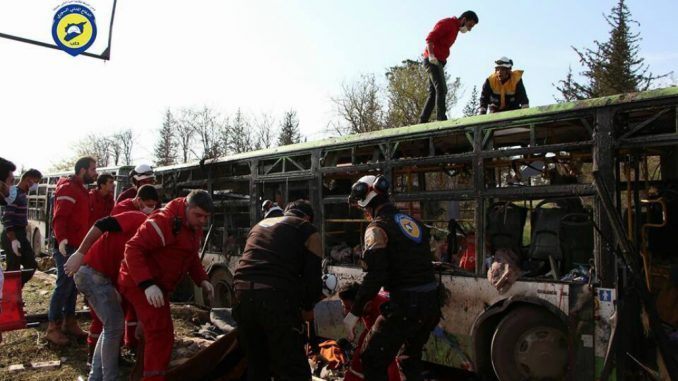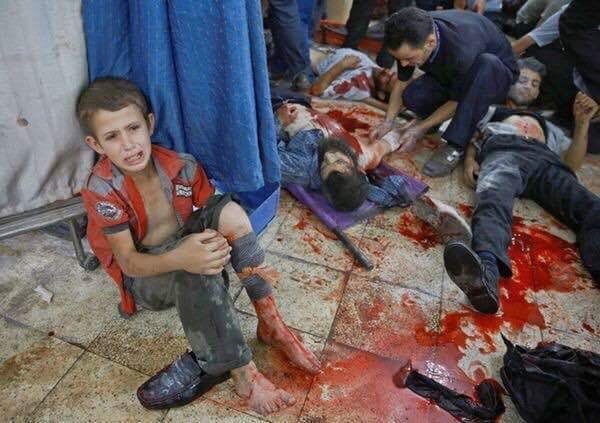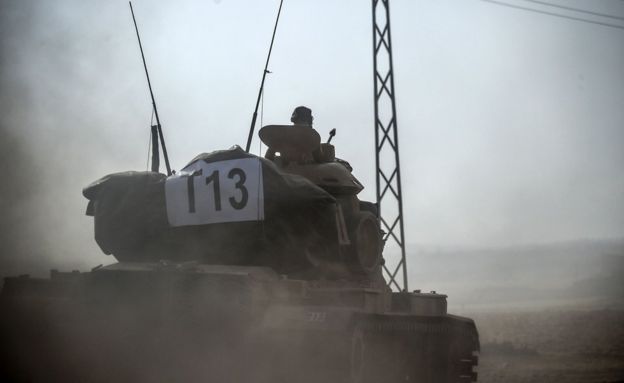
The evacuation process from four besieged areas in Syria, under a deal between the rebels and Assad regime, was resumed on Wednesday after being stopped for several days after a deadly bomb attack that left 126 evacuees dead.
After long months of siege, bombing, and starvation the rebels were forced to sign a new deal with the Assad regime, which includes lifting the siege on two towns in rural Damascus in exchange for evacuating their citizens to northern Syria and allowing two rebel-besieged towns to be evacuated too.
As diplomacy in Moscow focused on the U.S. airstrikes targeting Syria, more than 2,350 people were bused out of the twin rebel-held towns of Madaya and Zabadani near Damascus, and another 5,000 from the pro-government towns of Foua and Kefraya in the country’s north.
Madaya and Zabadani, once summer resorts to Damascus, have been shattered under the cruelty of government siege. The two towns rebelled against Damascus’ authority in 2011 when demonstrations swept through the country demanding the end of President Bashar Assad’s rule.
Residents were reduced to hunting rodents and eating the leaves off trees. Photos of children gaunt with hunger shocked the world and gave new urgency to U.N. relief operations in Syria.
Foua and Kfraya, besieged by the rebels, lived under a steady hail of rockets and mortars. However, they were supplied with food and medical supplies through military airdrops.
Madaya and Zabadani are the latest in a constellation of towns once held by the opposition around Damascus to surrender to the regime.
Critics say the string of evacuations, which could see some 30,000 people moved across battle lines over the next 60 days, amounts to forced displacement along political and sectarian lines.
However, the deal was stopped on Saturday after a bomb attack targeted evacuated from the two Shiite villages near Aleppo, leaving more than 126 killed most of them are women and children.
The suicide attack
The explosion on Saturday in Rashidin, west of Aleppo, targeted residents who were evacuated from the rebel-besieged towns of Foua and Kefraya in Idlib province under the deal.
It shattered coaches and set cars on fire, leaving a trail of bodies including children, as the convoy waited in rebel territory near Aleppo.
A suicide bomber driving a van supposedly carrying aid supplies blew it up near the coaches, the UK-based Syrian Observatory for Human Rights reports.
“A van was distributing crisps,” one civilian evacuee told Zaman English News. “Children started running after it. It then exploded.”
At least 45 body bags were counted at the scene of the blast, while White Helmets rescuers, who operate in rebel-held areas, said at least 100 people had been killed. Many were also injured.
The Observatory on Sunday said at least 126 people were killed in the blast, raising a previous death toll of 112.
At least 68 children were among those killed, the monitor said.
The Syrian Civil Defence, a volunteer rescue group that operates in rebel-held parts of Syria, had said on Saturday that at least 100 people were killed, while a report on Syrian state TV had given a death toll of 39.
Pictures posted on state media showed what appeared to be the aftermath of the explosion, with burned bodies and fires belching out thick black smoke.
Buses were blackened by the blast with their windows blown out.
“It appears that the explosion happened at the front of the convoy, which is about 70 buses long. Apparently it happened in an area where the sick and the injured were either being transferred or swapped,” journalist Hoda Abdel-Hamid said,
“We do understand that the casualties go into the dozens … among them women and children and some of the rebel fighters that were there to secure that convoy.”
Opposition activists said that the van that exploded belonged to Assad regime and was sent form areas under its role,
Victims: Displaced Syrians & rebels.
Rescuers: Revolutionary fighters, media activists & volunteers.
Car bomb: Assad "aid" truck. #Syria pic.twitter.com/ditiE262ei— شبكة الثورة السورية (@RevolutionSyria) April 16, 2017
Evacuations resumed
A large convoy of buses from Foua and Kefraya reached the edge of the rebel-held transit point of Rashidin outside the city of Aleppo.
“The process has resumed with 3,000 people leaving Foua and Kefraya at dawn and nearly 300 leaving Zabadani and two other rebel-held areas,” the head of the SOHR, Rami Abdel Rahman, told the AFP news agency.
The Syrian government’s Central Military Media also confirmed the resumption of evacuations.
Rashidin was the scene of Saturday’s deadly car bombing. At least 109 of the 126 dead were evacuees, among them 68 children. The rest were aid workers and rebels guarding the convoy.
Security was tightened up for Wednesday’s departures. Several dozen armed rebel fighters stood guard over the marshalling area where the buses were parked.
“There are 3,000 people, including fighters and their families, waiting in much the same way as they were on that fateful Saturday for the other buses from the other side to arrive,” a journalist said.
“One could only imagine what it must be like.”
After last weekend’s bomb attack, dozens of parents who had come from the government-controlled areas said their children had gone missing as survivors were rushed to nearby hospitals in opposition-held areas.
“It’s really a desperate situation,” Simmons said, adding that many worried parents were posting appeals on Facebook for their children to be located and retrieved
“What must be worse than anything for anybody are that injured children who have been stuck on the opposition side after the bombing; not seeing their parents, not being with their parents,” Simmons said.
Assad regime forces, helped by Russian air power and Iran-backed Shiite militias, has steadily ended armed opposition influence in the remaining pockets of resistance around the capital, in addition to many areas in Syria, using a series of army offensives and evacuation agreements, after years of siege, starvation, and daily bombing.
Assad regime describes the evacuation deals as “reconciliation” or “settlement agreements”, but rebels say they involve the forcible displacement of whole communities from opposition areas after years of siege and bombardment.
The Syrian crisis began as a peaceful demonstration against the injustice in Syria. Assad regime used to fire power and violence against the civilians and led to armed resistance. 450.000 Syrians lost their lives in the past five years according to UN estimates, and more than 12 million have lost their homes.



